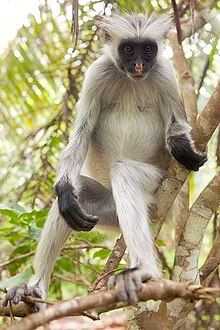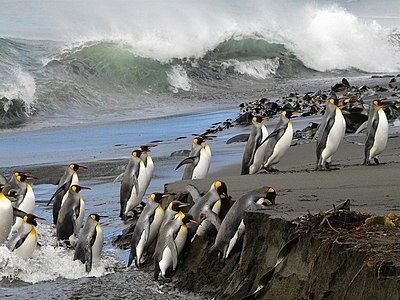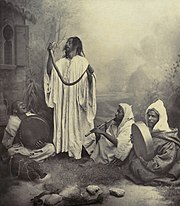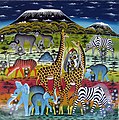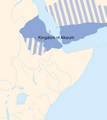Portal:Africa

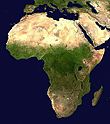

Africa is the world's second-largest and second-most populous continent after Asia. At about 30.3 million km2 (11.7 million square miles) including adjacent islands, it covers 20% of Earth's land area and 6% of its total surface area. With nearly 1.4 billion people as of 2021, it accounts for about 18% of the world's human population. Africa's population is the youngest among all the continents; the median age in 2012 was 19.7, when the worldwide median age was 30.4. Based on 2024 projections, Africa's population will reach 3.8 billion people by 2099. Africa is the least wealthy inhabited continent per capita and second-least wealthy by total wealth, ahead of Oceania. Scholars have attributed this to different factors including geography, climate, corruption, colonialism, the Cold War, and neocolonialism. Despite this low concentration of wealth, recent economic expansion and a large and young population make Africa an important economic market in the broader global context. Africa has a large quantity of natural resources and food resources, including diamonds, sugar, salt, gold, iron, cobalt, uranium, copper, bauxite, silver, petroleum, natural gas, cocoa beans, and.
Africa straddles the equator and the prime meridian. It is the only continent to stretch from the northern temperate to the southern temperate zones. The majority of the continent and its countries are in the Northern Hemisphere, with a substantial portion and a number of countries in the Southern Hemisphere. Most of the continent lies in the tropics, except for a large part of Western Sahara, Algeria, Libya and Egypt, the northern tip of Mauritania, and the entire territories of Morocco and Tunisia, which in turn are located above the tropic of Cancer, in the northern temperate zone. In the other extreme of the continent, southern Namibia, southern Botswana, great parts of South Africa, the entire territories of Lesotho and Eswatini and the southern tips of Mozambique and Madagascar are located below the tropic of Capricorn, in the southern temperate zone.
Africa is highly biodiverse; it is the continent with the largest number of megafauna species, as it was least affected by the extinction of the Pleistocene megafauna. However, Africa also is heavily affected by a wide range of environmental issues, including desertification, deforestation, water scarcity, and pollution. These entrenched environmental concerns are expected to worsen as climate change impacts Africa. The UN Intergovernmental Panel on Climate Change has identified Africa as the continent most vulnerable to climate change.
The history of Africa is long, complex, and varied, and has often been under-appreciated by the global historical community. In African societies the oral word is revered, and they have generally recorded their history via oral tradition, which has led anthropologists to term them oral civilisations, contrasted with literate civilisations which pride the written word. During the colonial period, oral sources were deprecated by European historians, which gave them the impression Africa had no recorded history. African historiography became organized at the academic level in the mid-20th century, and saw a movement towards utilising oral sources in a multidisciplinary approach, culminating in the General History of Africa, edited by specialists from across the continent. (Full article...)
Selected article –
The Zanzibar red colobus (Piliocolobus kirkii) is a species of red colobus monkey endemic to Unguja, the main island of the Zanzibar Archipelago, off the coast of Tanzania. It is also known as Kirk's red colobus after Sir John Kirk, the British Resident of Zanzibar who first brought it to the attention of zoological science. It is now classified as an endangered species and in the mid-1990s was adopted as the flagship species for conservation in Zanzibar. The population is still decreasing, and conservationists are attempting to work with the local government to devise a proper, effective strategy to protect the population and habitat. Challenges include the species' habitat, which is limited to the archipelago. The species has been reclassified three times; it was previously in the genus Colobus, then in the genus Procolobus, and later in the genus Piliocolobus. (Full article...)
Featured pictures –
Did you know (auto-generated) -

- ... that land for a library built for African Americans in Virginia was donated by Pope Pius XII?
- ... that the South Australian Labor politician Ernest Roberts served two tours in South Africa during the Second Boer War?
- ... that archaeologists found that Updown Girl, who was buried in England in the 7th century, had a mixture of West African and European DNA?
- ... that Freetown, Alabama, was founded by free and formerly enslaved African Americans in Alabama, whose church, built in 1929, burned down in 2022?
- ... that although it was only formed in late 1939, the French 87th African Infantry Division inflicted 6,600 casualties upon the German forces and fought until the very end of the Battle of France?
- ... that Godwin Obasi has been described as "Africa's gift to the world of climate science"?
Categories
Selected biography –
Thomas Joseph Odhiambo Mboya (15 August 1930 – 5 July 1969) was a Kenyan trade unionist, educator, Pan-Africanist, author, independence activist, and statesman. He was one of the founding fathers of the Republic of Kenya. He led the negotiations for independence at the Lancaster House Conferences and was instrumental in the formation of Kenya's independence party – the Kenya African National Union (KANU) – where he served as its first Secretary-General. He laid the foundation for Kenya's capitalist and mixed economy policies at the height of the Cold War and set up several of the country's key labour institutions. Mboya was Minister for Economic Planning and Development when he was assassinated.
Mboya's intelligence, charm, leadership, and oratory skills won him admiration from all over the world. He gave speeches, participated in debates and interviews across the world in favour of Kenya's independence from British colonial rule. He also spoke at several rallies in the goodwill of the Civil Rights movement in the United States. In 1958, at the age of 28, Mboya was elected Conference Chairman at the All-African Peoples' Conference convened by Kwame Nkrumah of Ghana. He helped build the Trade Union Movement in Kenya, Uganda and Tanzania, as well as across Africa. He also served as the Africa Representative to the International Confederation of Free Trade Unions (ICFTU). In 1959, Mboya called a conference in Lagos, Nigeria, to form the first All-Africa ICFTU labour organization. (Full article...)
Selected country –
 |
 |
||

| |||
Uganda, formally the Republic of Uganda, is a landlocked country in East Africa, bordered on the east by Kenya, on the north by Sudan, on the west by the Democratic Republic of the Congo, on the southwest by Rwanda, and on the south by Tanzania. The southern part of the country includes a substantial portion of Lake Victoria, within which it shares borders with Kenya and Tanzania. The country is located on the East African plateau, averaging about 900 metres (2,950 ft) above sea level. Uganda takes its name from the Buganda kingdom, which encompasses a portion of the south of the country including the capital Kampala.
The President of Uganda, currently Yoweri Museveni, is both head of state and head of government. The president appoints a prime minister who aids him in his tasks. The current prime minister is Apolo Nsibambi. The parliament is formed by the National Assembly, which has 303 members. Eighty-six of these members are nominated by interest groups, including women and the army. The remaining members are elected for five-year terms during general elections. (Read more...)
Selected city –
Djibouti (also called Djibouti City and Jibuti in early Western texts) is the capital city of the Republic of Djibouti. It is located in the coastal Djibouti Region on the Gulf of Tadjoura.
Djibouti has a population of around 780,000 inhabitants, which counts for 73% of the country's population. The settlement was founded in 1888 by the French, on land leased from the ruling Somali and Afar Sultans. During the ensuing period, it served as the capital of French Somaliland and its successor the French Territory of the Afars and Issas. (Full article...)
In the news
- 22 January 2025 – Constitutional crisis in Somalia, Transport in Somalia
- The Somali Airlines Operators Association, representing at least 20 airlines, has suspended all flights starting January 22, 2025, in protest against increased government-imposed fees after disputes with the Ministry of Aviation and the Somali Civil Aviation Authority. (Shabelle Media) (Hiiraan Online)
- 21 January 2025 – Kivu conflict
- M23 rebels seize the town of Minova in Kalehe Territory, Democratic Republic of the Congo, cutting off a major supply route to the strategic city of Goma. (Reuters)
- 21 January 2025 –
- Four people are injured, one seriously, in a stabbing attack in Tel Aviv, Israel. The Shin Bet confirmed that the attacker was 28 years old from Morocco and had American permanent residency. (BBC) (The Times of Israel) (Xinhua)
- Twenty Ethiopian migrants are killed when their boat capsizes off Yemen after departing from Djibouti, according to the International Organization for Migration. (Al Arabiya)
- 18 January 2025 –
- Ghanian soldiers open fire on illegal miners at a gold mine in Ashanti Region, killing seven people. Ghanian president John Mahama calls for an investigation into the incident. (AP)
- 18 January 2025 – 2025 Suleja fuel tanker explosion
- At least 86 people are killed and several others are injured when a fuel tanker overturns on a highway in Suleja, Niger State, Nigeria, and later explodes when people gather to collect the spilled fuel. (Vanguard) (The Straits Times)
Updated: 3:05, 23 January 2025
General images -
Africa topics
More did you know –
- ... that Liberia College in the country of Liberia was authorized by the legislature in 1851, but did not start classes until 1863?
- ... that the forced removal of 700,000 people from slums in Zimbabwe in 2005 was called "a crime against humanity" by the UN?
- ... that the supreme god of the southern African Bushmen is Cagn, a trickster who shapeshifts into a praying mantis?
- ... that Bahá'í Faith in Niger began during a period of wide scale growth in the religion across Sub-Saharan Africa near the end of its colonial period?
Related portals
Major Religions in Africa
North Africa
West Africa
Central Africa
East Africa
Southern Africa
Associated Wikimedia
The following Wikimedia Foundation sister projects provide more on this subject:
-
Commons
Free media repository -
Wikibooks
Free textbooks and manuals -
Wikidata
Free knowledge base -
Wikinews
Free-content news -
Wikiquote
Collection of quotations -
Wikisource
Free-content library -
Wikispecies
Directory of species -
Wikiversity
Free learning tools -
Wikivoyage
Free travel guide -
Wiktionary
Dictionary and thesaurus

